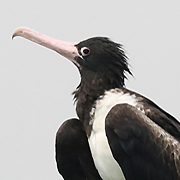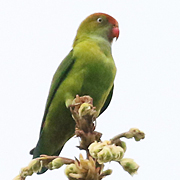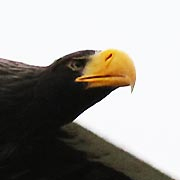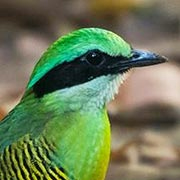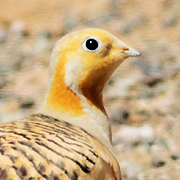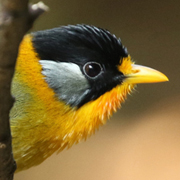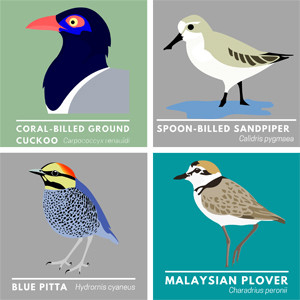On the evening of the 22nd February I joined up with Masayuki and Yasue Shimada from Japan for a few days birdwatching in Thailand at Kaeng Krachan and Laem Pak Bia/Pak Thale.
Travelling in the evening we stopped in the town of Petburi for some food – finding an open air food court serving cheap and tasty food. We arrived at our accommodation at about 9.30pm and found the Gaeng Phet Resort to be very busy with Thais spending the weekend here. Still, the owners were helpful in arranging breakfast for the early morning and taking an order for a packed lunch to take into the park.
23rd February
We were into Kaeng Krachan national park by 6.30 am, just as it was getting light. we decided to stop along the way to observe some of the many birds that can be found along the access road. Green-eared Barbet is always easy here and we also found a Blue-eared Barbet calling from a dense tree. Woodpeckers are fairly common along this stretch of road and we managed to get good views of Greater Yellownape and Greater Flameback as well as a few Grey-headed Woodpeckers.
Unusually things became a little quiet and for a while we had to make do with a variety of bulbuls before coming across 2 very handsome White-rumpoed Shamas in full song having a territorial dispute. At this same spot we also managed to call out a group of very curious Puff-throated Babblers and saw our first hornbills; Oriental Pied Hornbills.
A little further along the road a Red Junglefowl made us stop and a group of 7 Thick-billed Pigeons gave us a very obliging show. While we struggled to find much of interest here a Drongo Cuckoo began calling and eventually flew into view. It was very nice to see this character, particularly as it began calling as we watched.
Reaching the campsite at Ban Krang we walked along the road finding some of the commoner forest birds; Ochraceous Bulbul, Greater Racket-tailed Drongo, Great Iora, Blue-winged Leafbird etc. but as the day grew hotter we went back to the campsite and ate our lunch in the shade of the shelter there. As we finished eating Yasue spotted some birds in the stream behind us and a Crested Goshawk flew overhead doing its distinctive display of fluttering wings and heavily puffed out white undertail coverts. The Goshawk continued to fly about, displaying and then a male Crimson Sunbird came in to visit us.
At 1 pm the road opens to traffic going uphill and we used this opportunity to get a bit further along the road. Although things were fairly quiet we added Velvet-fronted Nuthatch, Blue-throated Flycatcher, Verditer Flycatcher and Grey-headed Canary Flycatcher to our list. Eventually we found a tree hanging over the road which was bearing some fruit and as usual with such trees, there were birds to be seen. Bulbuls included Black-crested, Black-headed, Grey-eyed and Ochraceous and a male Asian Fairy Bluebird caught the eye but it was a single Little Cuckoo Dove that was most noteworthy. This species is anything but common and was a nice bird for everyone.
Again things became quiet as they often do in the afternoons when forest birding and we struggled to see Large Woodshrike. However, one last push before leaving for the evening was worth it as we gained a superb view of an Asian Barred Owlet being harrassed by 2 Grey-headed Canary Flycatchers who obviosly didn’t appreciate this species as much as we did. A little further along we ran into a splendidly confiding Green Magpie which was not at all shy and allowed us to watch him feeding.
With this we moved along. One the way back we discovered that the entrance road is excellent as light is failing, although the park rangers ask people to be out well before dark due to the danger of elephants. We saw a number of Greater Flamebacks and also some roosting Golden-crested Mynas before heading back for dinner. However, there was one more treat in store. I heard a calling Indian Nightjar and managed to spotlight it very quickly by the lakeside for us all to see – an excellent end to the day.
24th February
Our second day in Kaeng Krachan was much anticipated, and we had a different strategy for the day – to get straight into the moist forest near Ban Krang. However, the drive in was very birdy and we found it impossible not to stop. This was fine as it got us better views of Golden-crested Myna and added Hill Myna into the bargain; we also found a tree with a number of woodpeckers on it, including Common Flameback and a pair of Heart-spotted Woodpeckers.
With brief stops for Dollarbird, Spangled Drongo, Black-naped Oriole and other forest species we got to Ban Krang 1 minute after the gate closed for uphill traffic (7.30am). This meant we had to walk again, but this had its bonuses – in particular 3 Great Hornbills which flew across the valley. The forest was kind to us this morning with many Lesser Necklaced Laughingthushes, a Green Magpie, 2 Sultan Tits and a flock of Silver-breasted Broadbills. On a distant snag we managed to ‘scope a Buff-rumped Woodpecker which was then joined by a pair of Greater Flamebacks.
Shortly after this we spotted a Black-thighed Falconet on a dead tree and spent some time watching this bird through the telescopes until a group of Leaf Monkeys drew our attention.
Unfortunately, just as we were getting lots of birds the downhill traffic began to come down and this made birding quite unpleasant for some time. Fortunately, Masayuki and Yasue were very persistent and patient birders and slowly but surely we hunted down a number of nice birds, Hainan Blue Flycatcher, Rufous-fronted Babbler, Black-naped Monarch and Eastern Crowned Warbler being just a few. Our turning back point was to be the Brown Hornbill nest tree and we were so lucky to get superb views of the pair sitting in full view on the tree. We managed to get the birds in the telescope and could see that they were using a dead lizard asa courtship offering. This excellent sight was our cue to go back for lunch but our luck continued with a great sighting of a soaring Black Eagle and 2 Wreathed Hornbills flying over at low altitude.
Lunch was taken at the ranger station at Ban Krang where some photographers alerted us to a Chinese Blue Flycatcher. This bird is not in many field guides, being previously treated as a subspecies of Blue-throated Flycatcher. Also at this spot was the regular pair of White-rumped Shamas.
When lunch was finished it was time to go uphill to Panoen Tung for a few hours. The road uphill is quite horrible and whilst a 4 wheel drive is not as absolute essential, it is advisable and a vehicle with good ground clearance is a must even for getting across the streams near Ban Krang.
Being the afternoon we struggled a bit at Ban Krang but we were happy with Vernal Hanging Parrot, Himalayan Swiftlet, White-browed Scimitar Babbler, Moustached Barbet, Blue-throated Barbet, Flavescent Bulbul, Mountain Imperial Pigeon, White-rumped Munia and Orange-bellied Leafbird.
This short trip to the high point of the park was over very quickly and we descended before the gate closed. On the way we stopped along the very productive road getting many excellent sightings of woodpeckers, hornbills and barbets.
Finally we went back for a nice dinner and a well-deserved shower.
25th February
Another early start to get to some freshwater wetlands near Petburi was tiring for everyone. However, it was worth it as these paddies are very birdy in the morning. Species such as Green Bee-eater, Indochinese Bushlark, Plain-backed Sparrow, Baya Weaver, Long-tailed Shrike, Black-capped Kingfisher and many other open-country birds are very common here and we had good views of all of these. We decided to take a short walk into the paddies and were rewarded with a female Fulvous-breasted Woodpecker.
Birding here consists of driving along the road and stoppi g at various points and we picked up some good birds in this way. A couple of Oriental Pratincoles were good for the time of year and a field being prepared for sowing turned up Intermediate Egret and Blue-tailed Bee-eater. Whilst watching these a pair of Greater Spotted Eagles came over and circled above our heads – superb. Other raptors included Black-eared Kite, Black-shouldered Kite and Pied Harrier.
As we moved into some fishponds we found a few different birds with Purple Heron, Asian Openbill Stork, Pheasant-tailed Jacana and Bronze-winged Jacana being the most interesting.
With time creeping on we headed for Laem Pak Bia where we spent time appreciating the shorebirds. 7 Red-necked Pharalopes were nice and a first winter Pallas’s Gull was also good. Large numbers of all the common shorebirds were present as ever.
The focus of our trip though was the boat trip to the sand spit and we enjoyed Collared Kingfisher on the way out. At the spit our time was limited but we found Lesser Crested Tern, Great Crested Tern, Pallas’s Gull, Brown-headed Gull and Sanderling before the Malaysian Plover – one of Masayuki’s most wanted species. Into the bargain I found him the “White-faced Plover” which seems to be reliable here. As time was ticking down I spotted a very distant Chinese Egret; so distant in fact that I don’t think Masayuki and Yasue quite believed me. However, our boatman (Khun Daeng) skillfully got us close to the bird and we could quite clearly see that I was right. The last bird of the day was a passing Gull-billed Tern which rounded off the trip quite nicely; with over 180 species in 3 days we had to be happy.
birds, birding, thailand, nature, national parks


 March 10th, 2008
March 10th, 2008  Nick
Nick 

 Posted in
Posted in 
